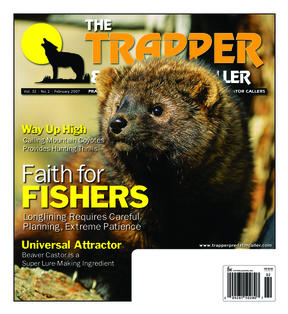Fur Market Report: February 2007
By Parker Dozhier
GENERAL OUTLOOK
Mother Nature has not been smiling on the fur trade this season. Along the East Coast, retailers are calling it the Coat Crisis. Balmy weather, as much as 15 degrees above normal, has stalled sales of winter coats. Furriers have been hit particularly hard.
Typically, the two weeks before Christmas is when the furs really fly off the racks.
“Didn’t happen this year,” one furrier lamented.
After the first of the year, furriers in the United States, Canada and Western Europe reportedly cut prices, often to razor-thin margins, in hopes of moving inventory.
The unseasonably mild winter might impact the movement of ranch mink, but it is not expected to affect the sale of most of our wild furs.
In North America, wild furs constitute only 8 percent of the fur garments sold. Our wild furs are consumed in Russia, Eastern Europe and the Far East.
A few days before Christmas, Moscow finally got its first real taste of winter weather. However, while it is now below freezing in most of Russia, the weather is considerably milder than normal.
We’ve seen this before — when raccoon skins backed up at collection points for nearly two years. We’ll have to wait to see how this season plays out.
The same weather that stalled retail sales has extended the productive harvest time nearly a month in much of the Northeast and Midwest. The typical snows that usually bury traplines and send animals to their dens have yet to reach the Eastern half of the nation.
The unusually mild winter and its impact on the harvest is a double-edged sword. While the harvest has been extended in some regions, other areas have been rendered inaccessible because of a lack of snow or ice thick enough to support snowmobiles.
Bob McQuay, spokesman for North American Fur Auctions, anticipates the February offering to be short on some important articles because of the lack of access to many critical trapping areas. However, McQuay said there is still time — weather permitting — to make up the shortage for the May sale.
Late-caught fur often shows signs of rubbing and the guard hairs do not demonstrate the luster associated with earlier fur.
Reports filtering in from around the country indicate the muskrat harvest remains in full swing. Open water, favorable weather and stronger prices have culminated in what will likely be a sizeable harvest. The large take is not expected to result in any downward price adjustments, though.
A recent early season ranch mink offering in Copenhagen drew an unusually large gathering of buyers — more than 300. And once again, prices advanced. Hong Kong/China fur merchants dominated the bidding, followed by the Russians and Greeks.
The ever-increasing prices of ranch mink are caused, in part, by the slide in value of the U.S. dollar. This small Copenhagen offering, consisting of only 1.2 million skins, was a practically a sell-out. This type of continuing ranch mink activity bodes well for our muskrat market.
An enormous amount of fur is required to feed the growing demand in Russia, Eastern Europe and China. Our North American wild furs, along with the harvest in other parts of the world, are only a small percentage of the fur consumed annually.
According to the International Fur Trade Federation, the global fur garment and trim trade amounted to $13 billion in fiscal year 2005. U.S. consumers spent $1.8 billion on furs.
Beyond warmth, fur is a symbol of success in Russia and China — and success is coming rapidly to many segments of these societies. Once, only the aristocracy in Russia or China was allowed to wear fur. We can look forward to these markets continued growth well into the foreseeable future.
The desire for fur is deeply ingrained in some cultures. That is certainly the case in Tibet and Mongolia. Wearing fur is more than a demonstration of status. It has a profound symbolic significance going far beyond merely status.
Our otters have been going into Tibet by way of China for more than 20 years. The first shipment departed from the St. Louis airport headed for Beijing in the summer of 1985. The next shipment was from the Ontario Trappers Association, in North Bay, Ontario, six months later.
In Tibet, the otter skins are used to adorn a long, flowing robe called a chuba.
Chubas are worn only two or three times a year during horse riding festivals. The robes are considered sacred and symbolic.
One shop in the town of Linxia had 1,833 otter skins for sale. About half of the skins were from India. In an interview, the shop keeper was quoted as saying, “the best otter skins are from India and Pakistan.”
Take the exiled Dalai Lama’s recent rants, mix in equal parts of CITES, smuggling, poaching, the WTO, untrained customs inspectors and the burning desire of the Chinese government to “save face” when the eyes of the world will be on China during the Olympics, and you have a recipe for disaster.
None of our legal otter will be headed to China this season.
